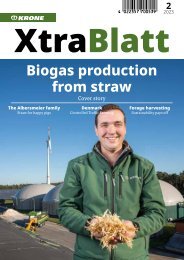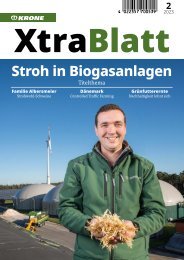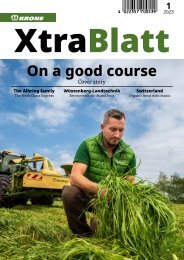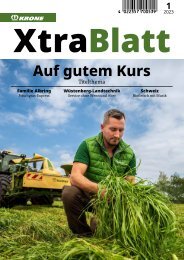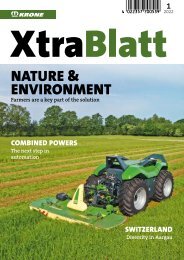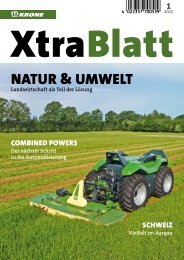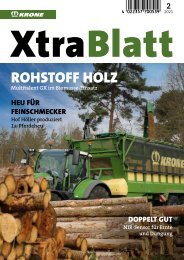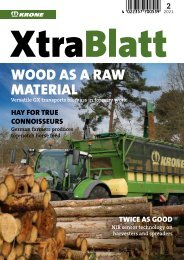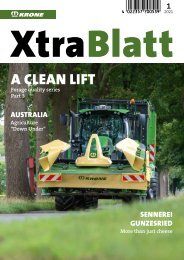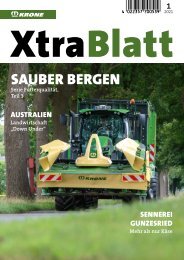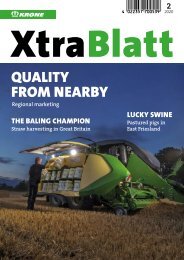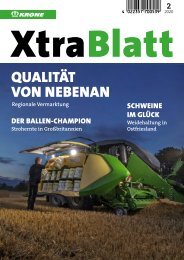XtraBlatt Issue 02-2017
Create successful ePaper yourself
Turn your PDF publications into a flip-book with our unique Google optimized e-Paper software.
3<br />
MAIZE FOR WEANERS ONLY<br />
Hay bales are kept dry in a variety of farm<br />
buildings while silage bales are stacked<br />
outdoors in three layers forming an imposing<br />
pyramid. Right behind this, there’s<br />
an equally impressive and neatly covered<br />
long row of straw bales. These are primarily<br />
used for bedding, although smaller<br />
amounts are used for feed. All straw is<br />
bought in. “While we do farm 30 ha arable<br />
land about 12 km away, we mainly use<br />
this for forage maize and feeding rye, explains<br />
Schlütter Snr. Incidentally, feeding<br />
rye is grown here instead of grass “because<br />
the geese don’t like rye so much,”<br />
adds his son.<br />
This brings the subject round to feeding<br />
in the Schlütter herd where cows get only<br />
hay and silage through the winter. The<br />
weaned calves also get maize silage and<br />
a little concentrate feed in their ration<br />
as they have to put on good body condition<br />
during the period up to their auction.<br />
There’s no mixer wagon, a Hoftrac<br />
loader being used for feeding. After all,<br />
the aim is not high performance, as with<br />
dairy cows or beef finishers, says Gisbert<br />
Schlütter. Still, feed uptake in the three<br />
herds is good and forage loss through “selection<br />
at the trough” low.<br />
Apropos selection: to the most exciting<br />
operations of the year undoubtedly belong<br />
those in November at housing, with<br />
the calves separated from their mothers<br />
at the same time. A general health check<br />
also takes place then, as well as worming<br />
and scanning for pregnancy. This is when<br />
the entire family is required, as well as<br />
outside helpers, for handling and housing<br />
in three herds up to 500 head. In <strong>2017</strong> this<br />
operation turned out especially stressful<br />
because two of the herds had mixed into<br />
one another when extremely low river levels<br />
in spring had allowed cows to walk<br />
round a fence. Separation during the grazing<br />
period was too dangerous, reckons<br />
Rolf Schlütter. “Limousin cows do not like<br />
it at all when someone gets too near their<br />
calves. This is a small disadvantage with<br />
this breed.” Despite this, he is very satisfied<br />
with his herd. Incidentally, the extreme<br />
low river levels just mentioned still<br />
did not bring to light any of the legendary<br />
golden cups or chains from Hagen von<br />
Tronje’s sunken treasure, smiles the farmer.<br />
But who needs things like this when<br />
they already have the splendid “Nibelung<br />
cows”?<br />
1 Senior family member Gisbert Schlütter<br />
also works nearly every day on the farm.<br />
2 Rolf Schlütter relies completely on round<br />
bales for feed and bedding material.<br />
Annually, this comprises up to 700 bales<br />
of silage, 300 of hay and 700 of straw.<br />
3 Weaned calf sales provide the farm<br />
income. The calves are fed up to 300 kg<br />
liveweight in the barn and then sold at<br />
auction.<br />
4 Own machinery, including the baler, is<br />
used for forage harvesting.<br />
4<br />
13



